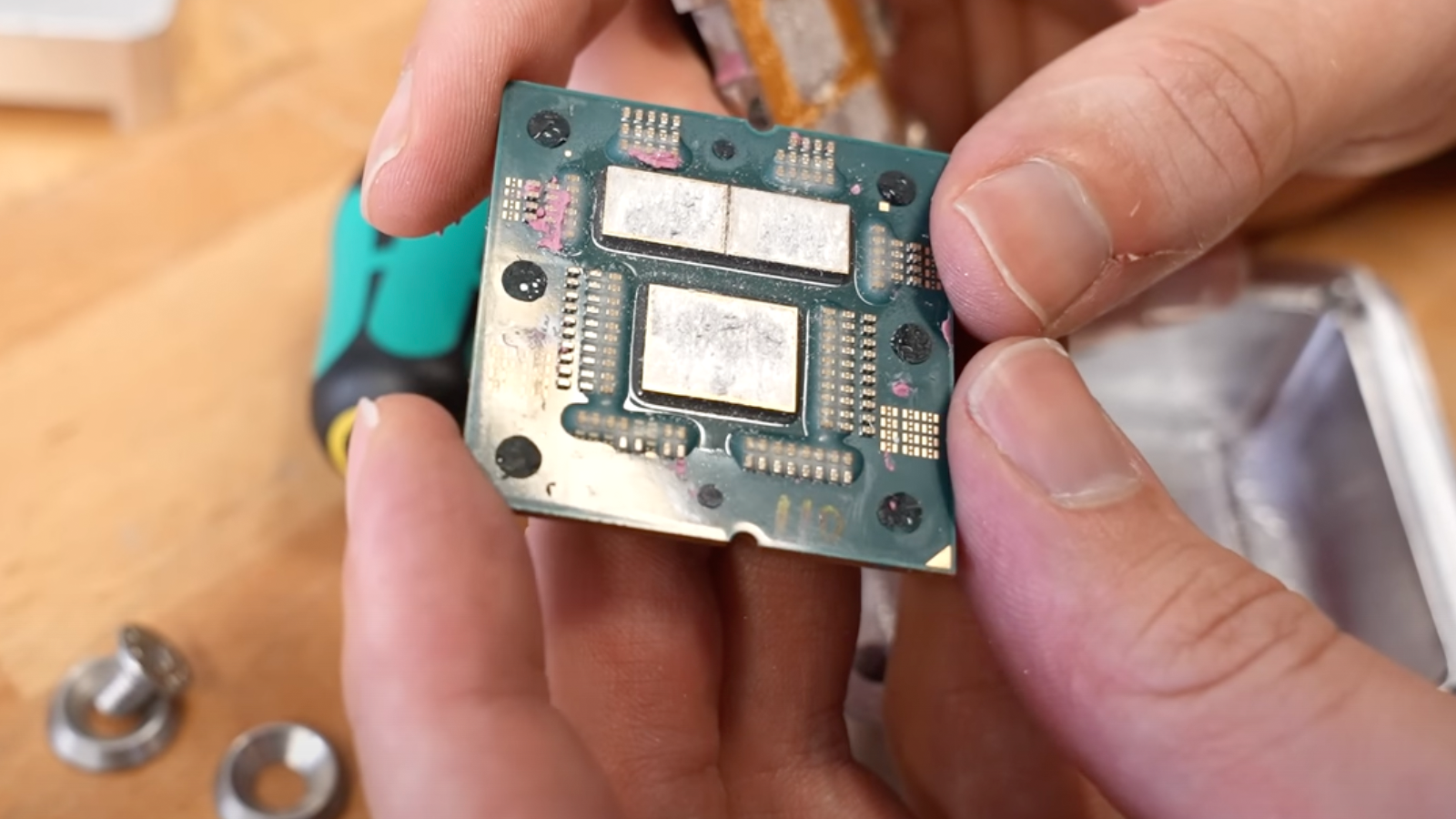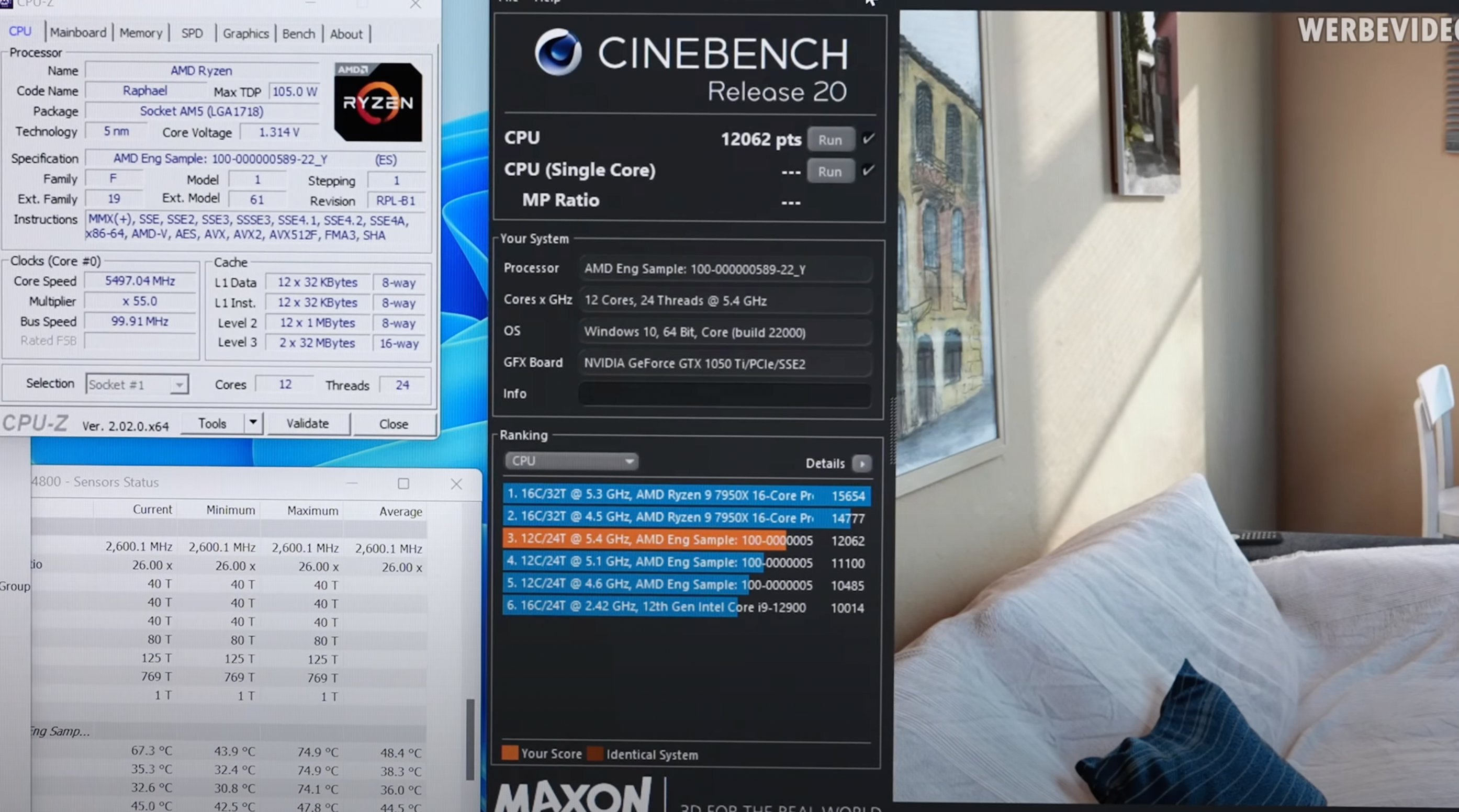Ryzen 9 7900X Delidded: Lower Temperature and 5.50 GHz on All Cores
Delidding does wonders to AMD's new Ryzen 7000 processors.
As AMD is rolling out its next-generation Ryzen 7000-series 'Raphael' processors, die hard overclockers are already finding ways to cool down these CPUs and push them to the limit. As reported by ExtremeTech Legendary overclocker Roman 'der8auer' Hartung this week delidded AMD's 12-core Ryzen 9 7900X processor and discovered that direct-die cooling lowers chip temperature by approximately 20 degrees Celsius under heavy loads.
Lowering CPU temperature by about 20 degrees Celsius in Cinebench (a resource heavy benchmark) enabled der8auer to increase the clocks on all 12 cores to 5.50 GHz by increasing the voltage by 30 millivolts. Even at 5.50 GHz on all 12 cores, the CPU temperature was only 74.9 degrees Celsius, which means that the processor has quite some headroom for further overclocking.
Integrated heat spreaders (IHS) are there to protect a fragile CPU die (or dies) and ensure decent contact with a cooling system in normal conditions. But IHSs as well as their thermal interface materials (TIMs) that attach them to dies are not always ideal from a thermal conduction point of view. Removing IHS can lead to more efficient cooling and better overclocking results, if you are brave enough to attempt it. Delidding (removing the IHS) a CPU usually leads to 10 – 15 degrees Celsius temperature reduction. In case of Der8auer's AMD Ryzen 9 7900X, the temperature difference in Cinebench R20 was about 20 degrees Celsius, well beyond typical expectations. There are possible explanations for this.

First up, AMD's IHS for AM5 CPUs is extremely thick, perhaps in a bid to maintain compatibility with previous-generation (AM4) coolers. Secondly, Roman 'der8auer' Hartung used his own liquid metal thermal grease that is not yet available and which is supposed to outperform existing liquid metal-based pastes as well as solder that AMD uses for its CPUs. New thermal interface is not going to dramatically lower temperature by itself, but a combination of direct-die cooling and new thermal grease can bring surprising results.



Since AMD only started to sell its Ryzen 7000-series processors on September 27, there are no off-the-shelf tools to delid these CPUs (so the overclocker had to custom-make one), there are no custom frames to hold a cooling system (again, he had to invent his own), it is hard for an average enthusiast to replicate Hartung's experiment. Nonetheless, the numbers speak for themselves. Lowering temperature by 20 degrees Celsius and pushing all twelve cores to 5.50 GHz is a big deal. Hartung says that eventually the delidding tool as well as custom AM5 frame for delidded CPUs will be available from his website.
Get Tom's Hardware's best news and in-depth reviews, straight to your inbox.

Anton Shilov is a contributing writer at Tom’s Hardware. Over the past couple of decades, he has covered everything from CPUs and GPUs to supercomputers and from modern process technologies and latest fab tools to high-tech industry trends.
-
TR909 There was a time there was no IHS on CPUs but "accidents" were happening from enthusiastic but inexperienced DIY'ers.Reply
I believe INTEL and AMD should make advancements in that part of the CPU so that we are able to get the maximum performance from modern processors, while keeping temps at normal levels. -
-Fran- Thanks for making this its own article, as I hope AMD understands the problem is not running the CPUs at 95°C because we fear it'll melt or break, but because the IHS is so bad it's leaving a lot of performance on the table hurting efficiency.Reply
I've heard and read other people say/write about delidding being just an extreme OC'er thing, but look at the data from a regular user perspective: the power draw to reach the same speeds goes down significantly without sacrificing performance; in fact, it goes up a lot! AMD just needs to improve how horrible bad the IHS performs to get some decent efficiency gains in Desktop, as in laptops we already have delidded CPUs an GPUs, so this is already seen there (where you could argue matters more?) and it shows how big the improvements are.
Maybe sell special delidded CPUs with a special mounting getting help from der8auer or something? There's a huge potential here for good press and AMD should capitalise on it. Unlike Intel and their complete avoidance of this topic, which keep in mind, also improves Intel's efficiency and they've been completely ignoring and saying "nope, not an issue". Don't be the same big headed moron, AMD. Come on.
Regards. -
rluker5 I think running a CPU really hot is a terrible inconvenience from an acoustic perspective. My pcs at home are tuned quiet. The ones at work that are cranking up the fans for trivial tasks give me feelings of disdain and anxiety.Reply
I know these things can run a lot cooler if you undervolt/underpower/underclock them and still have great performance. If AMD had a suitable IHS and HONEST clock tuning this wouldn't be a problem. Maybe the worst thermal performance in a human generation is out of desperation, but I think it is a prepared selling point for future products that will offer better, cooler performance because they don't have that IHS that is becoming an icon for bad IHS designs.
You can literally get half a generation of improvement with a little clock tuning and a normal IHS. Seems like such a low hanging fruit that it was placed there on purpose. It isn't like AMD is new at this. -
wifiburger fun...Reply
way too many things that can go wrong here with caps/resistors everywhere
somebody on reddit already killed his 7900x trying this -
helper800 Reply
And that was the risk he took trying to do something cool. It is what it is. One mans failure is another mans fun.wifiburger said:fun...
way too many things that can go wrong here with caps/resistors everywhere
somebody on reddit already killed his 7900x trying this -
Phaaze88 OK. How about how much more performance does this add though?Reply
... and without the all core OC, letting the algorithm boost on its own? -
Kamen Rider Blade The main issue with the current IHS compared to the previous one is you lost ALOT of flat surface area to transfer heat between the IHS and the CPU cooler.Reply
Yes, the THICC-er heatsink helps, Intel already did this before as well, it gives you extra heat soaking capacity.
But you still need more flat surface area to contact your CPU cooler for heat transfer and I hope AMD redesigns the IHS to fill out those large gaps by next gen Zen 5.
Losing that much Flat Surface Area is incredibly bad for Heat Transfer and that's why I think we need a improved IHS.
By my rough estimates, the current design lost ~30% of it's flat contact surface area on the outside to transfer heat between the IHS & CPU Cooler.
That WILL have an affect on temperature for the entire CPU. -
btmedic04 Optimum tech achieved a 30c and 50w reduction just with curve optimizer, setting a lower ppt and changing the thermal limit. All while maintaining stock out of the box performance on a 7700x.Reply -
dk382 Reply
The AM4 IHS fit entirely within the solid part of the AM5 IHS. The AM5 IHS is thus bigger and has more surface area than the previous IHS. It's not the surface area that's the problem here, it's the thickness. More thickness isn't better. You don't want the IHS to have a lot of thermal mass because then it becomes harder to dissipate that heat. You want it to have very little thermal mass but be highly efficient at transferring the heat to a cooler.Kamen Rider Blade said:The main issue with the current IHS compared to the previous one is you lost ALOT of flat surface area to transfer heat between the IHS and the CPU cooler.
Yes, the THICC-er heatsink helps, Intel already did this before as well, it gives you extra heat soaking capacity.
But you still need more flat surface area to contact your CPU cooler for heat transfer and I hope AMD redesigns the IHS to fill out those large gaps by next gen Zen 5.
Losing that much Flat Surface Area is incredibly bad for Heat Transfer and that's why I think we need a improved IHS.
By my rough estimates, the current design lost ~30% of it's flat contact surface area on the outside to transfer heat between the IHS & CPU Cooler.
That WILL have an affect on temperature for the entire CPU.
